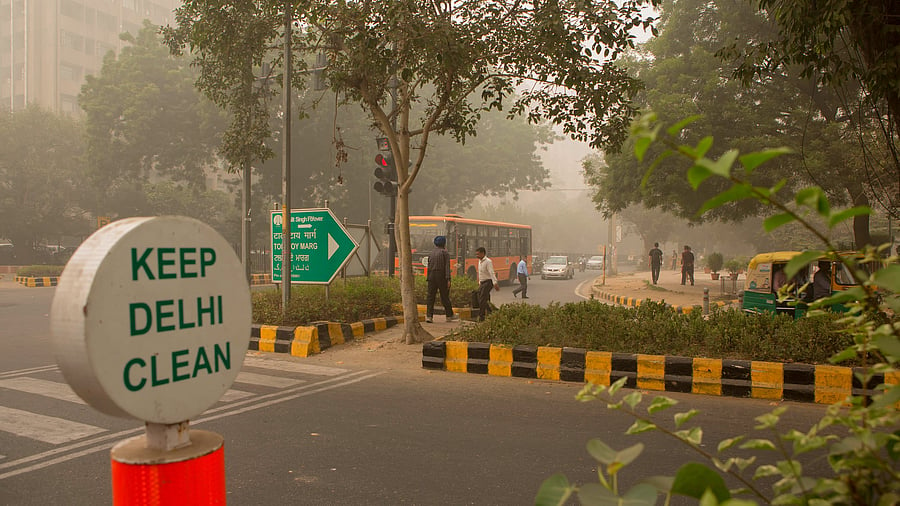
Image for representation.
Credit: iStock Photo
As Delhi swelters through the peak summer months, an invisible yet dangerous threat intensifies in the air. While winter pollution dominates headlines with its visible smog and stubble-burning debates, the summer air quality crisis [higher PM10 and PM2.5 concentrations, remains largely overlooked. Yet, from late March to June, Delhi faces a potent mix of pollutants, high PM10 levels, rising ground-level ozone, frequent dust storms, and emissions from construction, transport, and power sectors, that make the summer air just as harmful.
Unlike winter, which sees a dominance of fine particulate matter (PM2.5), summer pollution is driven more by coarser particles like PM10 and photochemical pollutants such as ozone. These pollutants, though less visible, have serious health implications. PM10 levels often exceed 300 µg/m3, triple the permissible national limit. Monitoring data from the Delhi Pollution Control Committee (DPCC) and Central Pollution Control Board (CPCB) show repeated exceedances across the city.
These high levels are driven by both natural and human factors. Dust storms originating from the Thar Desert and arid regions of western India and other countries frequently sweep into Delhi, carrying fine mineral particles over long distances. Extreme surface heating and high-pressure systems trap these pollutants close to the ground, reducing their dispersion. Simultaneously, unpaved roads, ongoing construction, and accumulated debris across the city contribute to local dust resuspension.
The frequency and intensity of these storms have increased in recent years due to shifting climate patterns. While alerts are issued by the India Meteorological Department (IMD), health responses on the ground remain limited. Hospitals report higher cases of respiratory and eye irritation during such events, but public health messaging and preventive action often lag.
Construction activity remains another major contributor to summer pollution. Regulations require large construction sites to register with DPCC and adopt dust control measures like green netting and water sprinkling. However, enforcement is weak, and compliance is inconsistent. Unregistered sites, demolition debris, and unpaved service roads add to the problem. Mechanised street sweeping and anti-smog guns have been introduced, but their effectiveness is hindered by poor maintenance and weak inter-agency coordination.
Vehicle emissions, though a year-round issue, worsen in summer. Higher temperatures increase fuel evaporation and put more load on engines. Despite the rollout of BS-VI fuel norms and stricter checks on Pollution Under Control (PUC) certificates, Delhi's vehicle numbers and traffic congestion continue to strain air quality. The Commission for Air Quality Management (CAQM) has mandated BS-VI compliance for all inter-state buses by late 2026, and RFID-enabled entry points monitor polluting vehicles, but a more rapid transition to cleaner public transport is essential.
Ground-level ozone, one of the most hazardous summer pollutants, forms when nitrogen oxides and volatile organic compounds react under strong sunlight. Unlike PM, ozone cannot be filtered by masks and directly impacts lung function, especially in children and older adults. Studies have reported ozone levels exceeding the safe threshold of 180 µg/m³, yet public awareness remains low.
Delhi’s soaring power demand during summer also worsens pollution. In 2024, peak demand exceeded 8,000 MW, much of it met through coal-based thermal plants in the surrounding region. These plants emit sulphur dioxide, nitrogen oxides, and particulates. Diesel generators, still widely used during power outages, add another layer of pollution. While rooftop solar and gas-based backups are slowly expanding, diesel gensets remain common due to lower initial costs.
To tackle these challenges, the Delhi government has implemented a 25-point summer action plan. Measures include stricter dust control at construction sites, enhanced street cleaning, greater use of anti-smog guns, and public grievance mechanisms via apps like Green Delhi and Sameer. Drones have been deployed to detect violations, and public advisories urge people to limit outdoor exposure during high-pollution hours.
At the central level, the CAQM has extended the Graded Response Action Plan (GRAP) to summer as well. Originally designed for winter, it now includes curbs on diesel generators, open burning, and operations of non-compliant industries even during the warmer months. This shift reflects a growing recognition that air pollution is a year-round crisis in Delhi.
Delhi is also a priority city under the National Clean Air Programme (NCAP), which aims to reduce PM levels by 40% from 2017 levels by 2026. NCAP supports road improvements, electric mobility, and monitoring infrastructure. Real-time air quality data from systems like SAFAR is now integrated into daily bulletins that help anticipate pollution spikes and guide response efforts.
Despite the scale of the problem, there are modest signs of progress. In 2024, Delhi recorded 209 days of ‘Good’ or ‘Moderate’ air quality, the highest since 2018, excluding the pandemic years. These gains reflect stronger enforcement, improved infrastructure, and growing public awareness. However, experts caution that these improvements are fragile and can be quickly reversed by unfavourable weather, especially calm and dry conditions that trap pollutants.
Delhi’s summer pollution problem demands urgent and sustained attention. It is not just dust or haze; it’s a combination of complex, harmful pollutants affecting millions silently. Tackling it requires stronger enforcement, better co-ordination between agencies, and faster adoption of clean energy and transport solutions. Recent flip-flops on measures like the fuel ban for older vehicles only underline the need for consistent, transparent policymaking.
Public awareness must also shift; air pollution is not a winter-only issue but a year-round public health emergency. Until this is recognised at all levels, from citizens to city planners to policymakers, summer will remain a season of silent suffering.
(Prabhat Sharma, Associate Fellow, and Suresh Ramasubramanya Iyer, Senior Fellow, Air Quality Research Division, The Energy and Resources Institute.)
Disclaimer: The views expressed above are the authors' own. They do not necessarily reflect the views of DH.